![]()
![]()
![]()
Use LEFT and RIGHT arrow keys to navigate between flashcards;
Use UP and DOWN arrow keys to flip the card;
H to show hint;
A reads text to speech;
79 Cards in this Set
- Front
- Back
|
Endocrine glands synthesize, store, & directly release their secretory products into the ___, resulting in physiological effects on target cells.
|
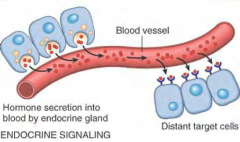
Blood stream
|
|
|
The ___ → anterior pituitary gland → releases TROPHIC hormones → specific endocrine glands → release hormones → exert ultimate actions on downstream tissues.
|
Hypothalamus
|
|
|
The pars ___ is the largest portion and produces most hormones.
|
Distalis
|
|
|
1. The Anterior pituitary is composed of:
2. The Posterior pituitary is composed of: 3. The pituitary gland is located in the ___ of sphenoid bone. |

1. Pars distalis, Pars intermedia, Pars tuberalis
2. Pars nervosa, Infundibular stalk 3. Sella turcica |
|

Cyst from failure of differentiation of oropharyngeal ectoderm of Rathke's pouch → complete or partial abscence of pars distalis & compression of neurohypophysis
Dx: |
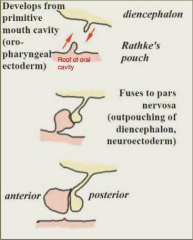
Pituitary cyst of Rathke's pouch
|
|
|
Pituitary cyst of Rathke's pouch → ___ (which is more COMMON in German Shepherds)
|
Pituitary dwarfism (Juvenile panhypopituitarism)
|
|
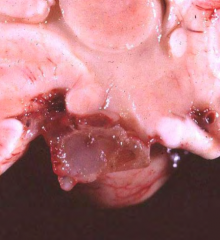
Identify the lesion and what does it lead to?
Lesion: Causes: |
Lesion: Pituitary cyst
Causes: Pituitary dwarfism (Juvenile Panhypopituitarism) |
|
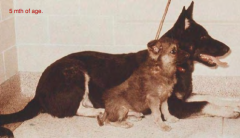
Both shepherds are of same age but the one in the foreground is developing abnormally.
Dx: |
Dx: Pituitary dwarfism (Juvenile Panhypopituitarism); will see stunted growth with partial alopecia
|
|

5-month old German Shepherd dog with areas of alopecia.
Dx: |
Dx: Pituitary dwarfism (Panhypopituitarism)
|
|
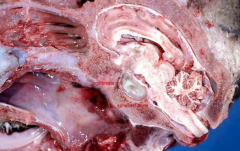
What is the lesion?
|
Pituitary abscess
|
|
|
How does a pituitary abscess originate?
|
Bacteria/mycotic agent (secondary to hematogenous spread)
|
|

The pituitary gland is notably enlarged because of an ___ of the ___ in horses. This neoplasm is associated with failure of hair shedding also known as ___.
|
Adenoma/pars intermedia/Hirsuitism
|
|
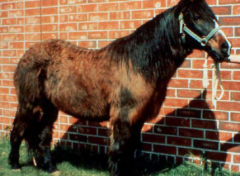
This horse is experiencing HIRSUITISM due to to an ___ of the ___.
|
Adenoma/pars intermedia
|
|
|
Horses affected with pituitary adenomas of the pars intermedia also present with...
|
Polyphagia (affects satiety center)
Hyperadrenocorticism (Equine Cushings Disease) PU/PD (no absorption of osmoles) Laminitis |
|
|
Hyperadrenocorticism in dogs is caused by a pituitary ___ of the ___.
|
Adenoma/pars distalis (Functional Chromophobe ("Corticotroph") Adenoma in Pars Distalis)
|
|

Identify the lesion.
Lesion: |
Lesion: Pituitary adenoma
|
|
|
What is the result of compression/destruction of the pars nervosa, infundibular stalk or supraoptic nucleus of the hypothalamus?
|
Central (Hypophyseal form) Diabetes Insipidus
|
|
|
What type of diabetes develops when target cells in the kidney LACK the biochemical pathways necessary to respond to ADH?
|
Nephrogenic Diabetes Insipidus
|
|
|
What hormone regulates the retention of water → ↑[urine] & reducing urine output?
|
ADH aka vasopressin
|
|
|
1. Administer ADH → ↑[urine], then Dx:
2. Administer ADH → NO ↑[urine], then Dx: |
1. Central Diabetes Insipidus
2. Nephrogenic Diabetes Insipidus (Defects in ADH receptors) |
|
|
Mnemonic to remember layers of adrenal glands and what they produce:
|
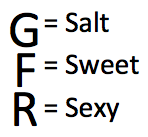
|
|
|
What cells of the adrenal medulla synthesize catecholamines, epinephrine & norepinephrine?
|
Pheochromocytes (chromaffin cells)
|
|
|
A common endocrinopathy in dogs with clinical signs associated with ↓corticosteroids (salt, sweet, sexy) including:
Hyperkalemia ↓gluconeogenesis ↑sensitivity to insulin |
Hypoadrenocorticism
|
|
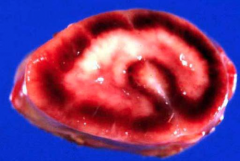
Rare adrenocortical hemorrhage as a consequence of overwhelming sepsis in horses.
|
Waterhouse-Friderichsen syndrome
|
|
|
The result of ischemia & fibrosis of Waterhouse-Friderichsen syndrome is ___ in horses.
|
Hypoadrenocorticisim
|
|
|
1. What agent is the most common cause of embolic suppurative nephritis/glomerulitis in foals?
2. In foals, adrenal hemorrhage is often a complication of bacterial sepsis, ___. |
1. Actinobacillus equuli
2. Waterhouse-Friderichsen syndrome |
|
|
A common endocrinopathy in ADULT/AGED dogs and infrequent in cats most commonly associated with a FUNCTIONAL CORTICOTROPH (ACTH-producing) PITUITARY ADENOMA.
|
Hyperadrenocorticism
|
|
|
In dogs, the pituitary adenoma is found in the pars ___, while in equine it is found in the pars ___.
|
Distalis/Intermedia
|
|

This dog presented with the following clinical signs:
Lordosis Bilateral alopecia PU/PD Dx: |
Dx: Hyperadrenocorticism
|
|
|
Why do dogs with Cushing's disease develop PU/PD?
|
Cortisol interferes with the release of ADH.
|
|
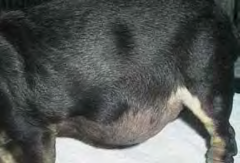
Pendulous abdomen ("potbelly appearance")
Cause? |
Cause: Hyperadrenocorticism→
↑Cortisol → Hyperglycemia (↓Glu intake) → Mobilization of fat/ **Muscle asthenia & Wasting** → **Hepatomegaly** & obesity |
|

Edx:
Cause? |
Edx: Steroid hepatopathy
Cause: Cushing's disease |
|
|
What are some immunosuppressive effects that arise from excessive cortisol?
|
・↓inflammatory mediators
・Inhibition of inflammatory cell migration ・Promotion of APOPTOSIS in leukocytes ・Inhibition of fibroblasts (affecting wound healing) |
|
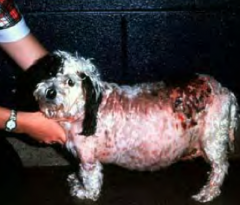
Non-pruritic bilateral symmetrical alopecia
Pendulous abdomen Dermatitis Dx: |
Dx: Hyperadrenocorticism/Cushion's disease with atrophic dermatopathy
|
|
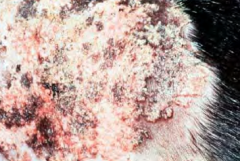
1. In approximately 30% of patients with hyperadrenocorticism may develop gritty & firm lesions. Name this condition.
2. What stain is used to confirm this? |
1. Name: Calcinosis Cutis (idiopathic)
2. Von Kossa stain |
|
|
Calcinosis cutis is diagnostic for...
|
Hyperadrenocorticism
|
|
|
What is the result of
・↓synthesis of vasodilator prostaglandins ・↑secretion of aldosterone in animals with hyperadrenocorticism? |
Hypertension → CHF, glomerulopathy, IO hemorrhage with retinal detachment
|
|
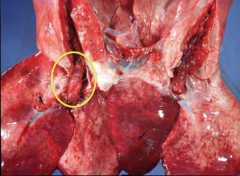
A complication arising due to a change in coagulable state (Hypertension → glomerulopathy)?
|
Pulmonary thrombosis
|
|
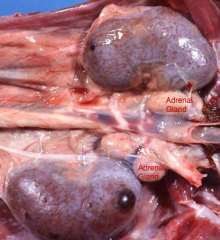
Cause of hyperadrenalcorticism in this dog?
Mdx: |
Cause: Since both are enlarged, we suspect
・PITUITARY ADENOMA ・IDIOPATHIC HYPERPLASIA Mdx: Bilateral adrenal hyperplasia |
|
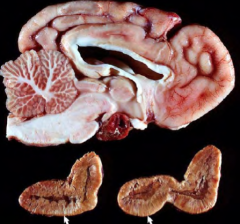
Cause of hyperadrenalcorticism in this dog?
|
Cause: Since both are enlarged, we suspect
・PITUITARY ADENOMA (ACTH-secreting Chromophobe Pituitary Adenoma) |
|

Tumor arising from adrenal cortex with ATROPH of the unaffected contra-lateral gland.
Dx: |
Dx: Adrenocortical adenoma
|
|
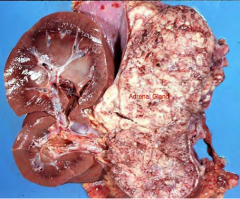
Tumor arising from adrenal cortex with ATROPHY of the unaffected contra-lateral gland.
Name this lesion. |
Adrenocortical carcinoma
|
|
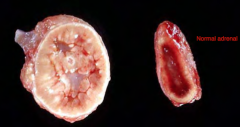
Hyperplastic a adrenal cortex with NORMAL contra-lateral gland.
Name this lesion & significance. |
Name: Adrenocortical hyperplasia
Significance: Age-related |
|
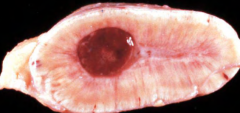
1. This tumor is more common in cattle & dogs and develop concurrently with calcitonin-secreting thyroid C-cell tumors.
2. What diagnostic feature will help us conclusively diagnose it? Tumor name (in adrenal medulla): Diagnostic feature: |
Tumor name (in adrenal medulla): Pheochromocytoma
Diagnostic feature: It has a tendency to invade the CAUDAL VENA CAVA |
|
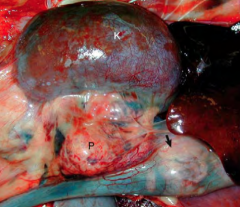
Dx:
Diagnostic feature: |
Dx: Pheochromocytoma
Diagnostic feature: It has invaded the CVC |
|
|
Functional pheochromocytomas (RARE) produce what clinical features?
|
Tachycardia
Cardiac hypertrophy Hypertension |
|
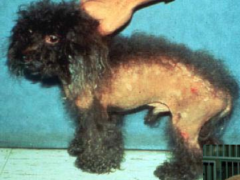
Non-pruritic bilateral symmetrical alopecia
Lethargy Weight gain ***Myxedema (accumulation of glycosaminoglycans (GAGs (thyroid hormone inhibits GAG accumulation)) = "Tragic" Facial Expression*** = diagnostic Dx: |
Hypothyroidism
|
|
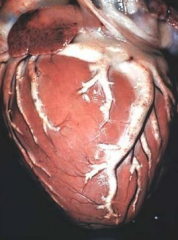
___ is associated with ___.
|
Coronary atherosclerosis/Hypothyroidism
|
|

Lesion:
Dx: |
Lesion: Coronary atherosclerosis
Dx: Hypothyroidism |
|
|
What are the MOST COMMON causes of hypothyroidism in dogs?
|
· Idiopathic Follicular (produce TGB) atrophy
· Lymphocytic (immune-mediated) Thyroiditis |
|

___ is the prominent skin folding over the eyes resulting from the accumulation of glycosaminoglycans (GAGs) (thyroid hormone inhibits GAG accumulation) & hyaluronic acid. This is diagnostic for ____.
Name: Diagnostic for: |
Name: Myxdema/"Tragic" Face
Diagnostic for: Hypothyroidism |
|
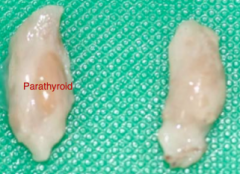
Histological findings: Thyroglobulin replaced by lymphocytes & adipose tissue. This leads us to suspect ___ leading to ___.
|
***Lymphocytic (immune-mediated) Thyroiditis*** (probably most common cause of hypothyroism in dogs)/Hypothyroidism
|
|
|
What should we examine closely for subtle changes during necropsy that will CONFIRM hypothyroidism?
|
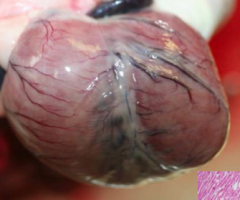
Coronary atherosclerosis
|
|
|
Define goiter:
|
Benign conditions in which the thyroid gland enlarges and swells.
|
|
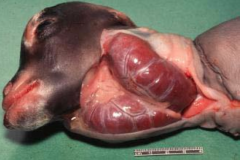
NON-NEOPLASTIC & NON-INFLAMMATORY enlargement of the thyroid gland (can be secondary to ↓iodine in mother's feed).
Dx: |
CONGENITAL Goiter (Goats)
Thyroid Hyperplasia Secondary to CONGENITAL Iodine Deficiency (Bovine) (↓T3/T4 = ↑TSH) |
|

Findings at necropsy: Active/Inactive in the following,
Cats: Dogs, Horses,: Mdx: |
Cats: Active (→ hyperthyroidism)
Dogs, Horses,: Incidental Mdx: Bilateral thyroid hyperplasia |
|

Name 2 causes of hyperthyroidism in cats:
|
· Thyroid Adenoma
· Nodular Thyroid Hyperplasia (type of goiter but ASYMMETRICAL) |
|
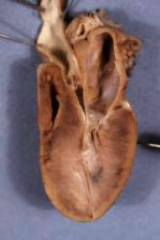
1. Hyperthyroidism is associated with ___ in cats.
2. What clinical signs are associated with hyperthyroidism in cats? |
1. Hypertrophic Cardiomyopathy (HCM)
2. PU/PD, weakness, ↑rate of BASAL metabolism, ↑appetite but losing weight. |
|
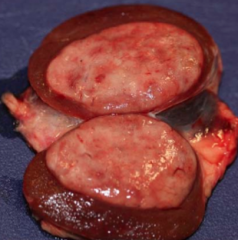
Post-mortem finding in the thyroid glands of a horse.
Mdx: Functional/Non-functional? |
Mdx: Thyroid Adenoma (well-demarcated)
Functional/Non-functional? Non-functional (functional only in cat) |
|

Post-mortem finding in the thyroid glands of a horse.
Mdx: |
Mdx: Thyroid Carcinoma (Invasive & non-functional)
|
|
|
Thyroid carcinomas tend to metastisize to the ___.
|
Lungs
|
|
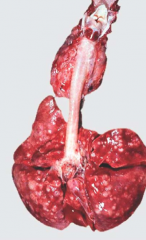
Post-mortem finding.
Mdx: |
Thyroid carcinoma with pulmonary metastases
|
|
|
Name 2 causes of hypoparathyroidism in dogs (particularly in smaller breeds):
|
· ***Lymphocytic parathyroiditis*** (Thyroid: Lymphocytic thyroiditis)
· Accidental removal of PT glands during thyroid SX. |
|
|
What clinical signs are associated with hypoparathyroidism in dogs?
|
· ↑NM excitability, tremors, & tetany
· Generalized tetany · HYPOCALCEMIA ([L] of PTH) & HYPERPHOSPHATEMIA (↑renal tubular reabsorption of P) |
|

Post-mortem finding around the thyroid glands of a dog. What can this lead to?
Dx: |
Dx: Parathyroid adenoma → Primary Hyperparathyroidism → Fibrous osteodystrophy [R] (↑osteoclast activity → loss of bone → replacement by fibrous connective tissue)
|
|
|
What may cause BILATERAL enlargement of the PT glands?
|
Secondary Hyperparathyroidism
1. Low Ca/ High P DIETS (→ ↑PTH secretion) 2. Renal dz (→ ↑P → ↑PTH secretion → ↑Ca) |
|
|
Describe the pathogenesis of humoral hypercalcemia of MALIGNANCY:
|
Anal sac apocrine gland carcinoma/lymphosarcoma → PTHrp → ↑Ca (PSEUDOHYPERPARATHYROISM/paraneoplastic hypercacemia)
|
|
|
Bone metastases → ↑Ca
Is this considered a paraneoplastic syndrome? |
No
|
|
|
Overstimulation/exhaustion of β CELLS →
|
Hydropic degeneration w/ glycogen accumulation (Vacuolar degeneration) of pancreatic islets → DM
|
|
|
Name the 2 types of primary diabetes:
Name 2 ways secondary diabetes can arise: |
1. Type I (IDDM) (insulin deficient)
Type II (NIDDM) (insulin resistant) = more common 2. Infectious diseases (pancreatitis, destruction of islets), Gestational diabetes |
|

Persistent hyperglycemia & formation of ADVANCED GLYCOSYLATION END PRODUCTS → vascular injury
|
Glomerulosclerosis (diabetic nephropathy)
|
|
|
Glucose metabolized in the lens → accumulation of large amounts of sugar alcohols (GLYCOSYLATION END PRODUCTS) → hypertonicity & opacity of lens
|
Diabetic cataracts
|
|
|
Obese rats → mutation in leptin receptor gene (stimulates satiety) →
|
Abnormal food intake → Hepatic lipidosis
|
|
|
DM in dogs is often the sequel of ___.
|
Pancreatitis (enough damage to pancreatic islets → DM)
|
|
|
What lesions are typically see in diabetic cases?
|
· Cataracts (bilateral)
· Chronic renal disease (pyelonephritis, renal papillary necrosis, glomerulosclerosis = diabetic nephropathy) · Pancreatitis (necrotizing, acute-chronic) → pancreatic atrophy · Coronary atherosclerosis |
|
|
___ is a protein normally produced in the beta cells of the pancreas along with insulin, as a response to high blood sugar. The high blood sugar temporarily suppresses beta cell insulin production, so that little insulin is made, but this substance continues to be produced building up and accumulating in the pancreas.
|
Islet amyloid polypeptide (IAPP)
|
|
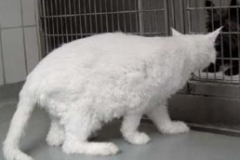
Build up of glucose → microvascular damage → demylination due to ↓perfusion → plantigrade stance in cats.
Dx: |
Diabetic neuropathy
|
|
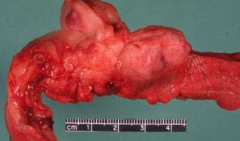
Neoplasm arising from β cells & benign → hypoglycemia.
Dx: |
Insulinoma (functional tumor)
|
|
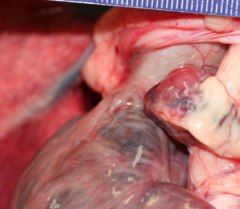
Neoplasm found at base of heart:
Significance? |
Neoplasm: Chemodectoma (neoplasm on RA = HSA)
Significance: Incidental finding |

